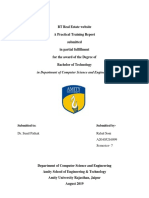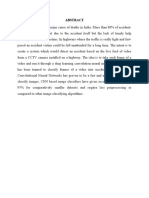Guru, Inter Vehicle Communication
Guru, Inter Vehicle Communication
Uploaded by
naveengoyal66Copyright:
Available Formats
Guru, Inter Vehicle Communication
Guru, Inter Vehicle Communication
Uploaded by
naveengoyal66Original Description:
Original Title
Copyright
Available Formats
Share this document
Did you find this document useful?
Is this content inappropriate?
Copyright:
Available Formats
Guru, Inter Vehicle Communication
Guru, Inter Vehicle Communication
Uploaded by
naveengoyal66Copyright:
Available Formats
Inter-Vehicular Communication Systems
Gurubachan Choudhary Roll no.-10EGJEC046 ECE(8th sem.) Gurubachan@live.in
ABSTRACT
Inter-vehicle communication (IVC) is emerging in research prominence for the interest that is generating in all major car manufacturers and for the benefits that its inception will produce. The specific features of IVC will allow the deployment of a wide set of possible applications which span from road safety to entertainment. Even if, on the one hand, these applications share the common need for fast multi-hop message propagation, on the other hand, they possess distinct characteristics in terms of generated network traffic. The current research state of the art only proposes solutions specifically designed for a single application (or class) that are not directly extendable to a general IVC context. Instead, we claim that a privileged architecture exists, which is able to support the whole spectrum of application classes. To this aim, we propose a novel IVC architecture that adapts its functionalities to efficiently serve applications in quickly propagating their messages over a vehicular network. We conducted an extensive set of experiments that demonstrate the efficacy of our approach. As representative case studies, we considered two application classes that for their network traffic characteristics are at the opposite boundaries of the application spectrum: safety and entertainment. Abstract. Driver assistance systems are meant to support drivers with driving process in order to avoid traffic accidents, speed up the traffic and have a higher control over the traffic in general. There are a lot of systems which give support to the drivers, such as adaptive cruise control, traffic sign recognition, automatic parking, etc. In this paper we focus on the vehicular communication systems. These systems use the capacity of the vehicles to communicate, not only between them but also with infrastructures. All the information is collected and processed to offer useful services. Wireless Sensor Networks (WSN) are widely used in this area. With the
incoming upgrades of these networks, they are becoming an attractive solution to give support with the communication mechanisms between vehicles. Keywords: ad hoc networks, wireless sensor networks, inter-vehicular communication, protocol.
You might also like
- Final Thesis PDFDocument32 pagesFinal Thesis PDFAbhishek MukherjeeNo ratings yet
- Kavach: Cab Signalling & Automatic Train Protection System for Digital RailwaysFrom EverandKavach: Cab Signalling & Automatic Train Protection System for Digital RailwaysNo ratings yet
- Seminar ReportDocument15 pagesSeminar Reportbihari kumarNo ratings yet
- Deep Learning Report Waqas PDFDocument16 pagesDeep Learning Report Waqas PDFMohammad Waqas Moin SheikhNo ratings yet
- Rohit Seminar ReportDocument24 pagesRohit Seminar ReportRohit Patil100% (2)
- Accident Avoiding System For Punching MachineDocument5 pagesAccident Avoiding System For Punching MachineParamesh Waran100% (1)
- Femtocell ReportDocument39 pagesFemtocell ReportAditi Gupta100% (1)
- Seminar ReportDocument34 pagesSeminar Reportabhay Maurya100% (1)
- Omni Wheels Robot For Effective Surveillance and Transportation PurposeDocument8 pagesOmni Wheels Robot For Effective Surveillance and Transportation PurposeIJRASETPublicationsNo ratings yet
- Technical Seminar Report AvDocument43 pagesTechnical Seminar Report AvGame rock SaiNo ratings yet
- Complete ADAS ReportDocument37 pagesComplete ADAS Reportd56468901No ratings yet
- Railway Track Security System Report PDFDocument26 pagesRailway Track Security System Report PDFeshu50% (2)
- Vikash Seminar ReportDocument31 pagesVikash Seminar ReportUpendra KumarNo ratings yet
- 8K Resolution Camera SystemDocument51 pages8K Resolution Camera SystemRutuja PawarNo ratings yet
- Smart Secure Andwarning System in Hair Pin Bends at Hill Stations Based On Zig Bee TechnologyDocument4 pagesSmart Secure Andwarning System in Hair Pin Bends at Hill Stations Based On Zig Bee TechnologyDaniel Pasy Seleka100% (1)
- Automatic Rain Operated Wiper SystemDocument20 pagesAutomatic Rain Operated Wiper SystemVinayaga ProjectinstituteNo ratings yet
- Seminar Deep LearningDocument17 pagesSeminar Deep LearningSulagna Roy ChowdhuryNo ratings yet
- Ai Project Report PDFDocument54 pagesAi Project Report PDFsai vickyNo ratings yet
- Tele ImmersionDocument30 pagesTele ImmersionPrashant AgarwalNo ratings yet
- Seminar Report AnkitDocument28 pagesSeminar Report AnkitBharat PanwarNo ratings yet
- Flywheel Energy Storage System: Bachelor of TechnologyDocument13 pagesFlywheel Energy Storage System: Bachelor of Technologymadhu kotlaNo ratings yet
- Major Project Shopping TrolleyDocument50 pagesMajor Project Shopping TrolleyRohith SharmaNo ratings yet
- Remf-133 Automatic Advanced Emergency Braking System and Parking System For Four WheelersDocument4 pagesRemf-133 Automatic Advanced Emergency Braking System and Parking System For Four WheelersretechNo ratings yet
- Drive by WireDocument5 pagesDrive by WirekarlNo ratings yet
- MTRCDocument10 pagesMTRCLalitha LalliNo ratings yet
- Automatic Railway Gate Control SystemDocument26 pagesAutomatic Railway Gate Control Systemprakhar agarwalNo ratings yet
- A Seminar Report OnDocument32 pagesA Seminar Report OnVineet KhandelwalNo ratings yet
- RayDocument17 pagesRayrayiz shameerNo ratings yet
- Seminar Report Artificial Intelligence in Power StationDocument31 pagesSeminar Report Artificial Intelligence in Power StationDiwakar DiwakarNo ratings yet
- Magenn Air Rotor System (M.a.r.sDocument21 pagesMagenn Air Rotor System (M.a.r.sccritamNo ratings yet
- VLC Based Vehicle To Vehicle CommunicationDocument2 pagesVLC Based Vehicle To Vehicle CommunicationIJRASETPublicationsNo ratings yet
- Automatic Railway Gate Control Using MicroDocument24 pagesAutomatic Railway Gate Control Using Microமணிவேல் சந்திரன்No ratings yet
- Automatic Bike Stand ReportDocument50 pagesAutomatic Bike Stand ReportSai Vamshi PranayNo ratings yet
- An IOT Based Smart Helmet For Accident Detection NotificationDocument23 pagesAn IOT Based Smart Helmet For Accident Detection NotificationFieldartNo ratings yet
- Design, Fabrication AND Analysis OF Rocker Bogie Mechanism: Mukt Shabd Journal ISSN NO: 2347-3150Document15 pagesDesign, Fabrication AND Analysis OF Rocker Bogie Mechanism: Mukt Shabd Journal ISSN NO: 2347-3150Tejas PrakashNo ratings yet
- Litreature On Automatic Dipper Circuit For Vehicle-2Document10 pagesLitreature On Automatic Dipper Circuit For Vehicle-2Rushikesh TajneNo ratings yet
- Final Report IntershipDocument23 pagesFinal Report IntershipShivam BajpaiNo ratings yet
- WJM Seminar Report PDFDocument14 pagesWJM Seminar Report PDFpalak mohodNo ratings yet
- Final Project Black Book-2Document55 pagesFinal Project Black Book-2Zafar ShaikhNo ratings yet
- Aamer Report SeminarDocument27 pagesAamer Report SeminarRohith NarayanNo ratings yet
- Brain Controlled Car For Disabled Using Artificial IntelligenceDocument17 pagesBrain Controlled Car For Disabled Using Artificial IntelligenceMdkhanzNo ratings yet
- Green Engine PPT 2Document23 pagesGreen Engine PPT 2asra tabassumNo ratings yet
- Deep Space Optical Terminals: Bachelor of Engineering in Electronics and Communication EngineeringDocument20 pagesDeep Space Optical Terminals: Bachelor of Engineering in Electronics and Communication EngineeringParu RJNo ratings yet
- Automatic Intelligent Braking System For Four Wheeler For Accident AvoidingDocument55 pagesAutomatic Intelligent Braking System For Four Wheeler For Accident AvoidingAjithNo ratings yet
- Design of Solar Powered Drainage Cleaning MachineDocument56 pagesDesign of Solar Powered Drainage Cleaning MachineNazeema TTNo ratings yet
- 35 (Gyro Bus) ReportDocument40 pages35 (Gyro Bus) ReportNehul PatilNo ratings yet
- Automatic Vehicle Locator: Presented by N. Rakesh 3RD B.tech (CSE) 08MU1A0536Document17 pagesAutomatic Vehicle Locator: Presented by N. Rakesh 3RD B.tech (CSE) 08MU1A0536Rakesh NaraharisettyNo ratings yet
- EcallDocument30 pagesEcallsajin_ramesh85% (13)
- Seminar Report On Automated Highway System: Mudit Srivastava 11610040 6 Semester, C-3Document28 pagesSeminar Report On Automated Highway System: Mudit Srivastava 11610040 6 Semester, C-3Mudit SrivastavaNo ratings yet
- Accident DetectionDocument61 pagesAccident DetectionRahul RepalaNo ratings yet
- Automatic Pneumatic Bumper For Four Wheeler Final Year Ieee Mech ProjectDocument60 pagesAutomatic Pneumatic Bumper For Four Wheeler Final Year Ieee Mech ProjectAnkit YadavNo ratings yet
- 1 Wireless Power TransmissionDocument27 pages1 Wireless Power TransmissionSriram ramsNo ratings yet
- Triangular Microstrip AntennaDocument16 pagesTriangular Microstrip AntennaGECM85No ratings yet
- Technical Seminar-Report Format Word MAGNERIDEDocument20 pagesTechnical Seminar-Report Format Word MAGNERIDEVinay K SNo ratings yet
- Face Mask DetectionDocument44 pagesFace Mask DetectionRasool ReddyNo ratings yet
- Self Learning and Efficient Health Status Analysis For A Core Router SystemDocument35 pagesSelf Learning and Efficient Health Status Analysis For A Core Router SystemSai Teja deevelaNo ratings yet
- Addis Ababa University Addis Ababa Institute of Technology School of Electrical and Computer EngineeringDocument23 pagesAddis Ababa University Addis Ababa Institute of Technology School of Electrical and Computer Engineeringbegziew getnetNo ratings yet
- A Technical Seminar Report On 3G V/S Wi-Fi: Bachelor of Technology IN Computer Science & EngineeringDocument23 pagesA Technical Seminar Report On 3G V/S Wi-Fi: Bachelor of Technology IN Computer Science & EngineeringKalyan Reddy AnuguNo ratings yet
- Skybus SeminarDocument17 pagesSkybus SeminarBiraj NaskarNo ratings yet
- Seminar Report 4D Printing TechnologyDocument8 pagesSeminar Report 4D Printing TechnologyChandan Shaiva0% (1)



























































